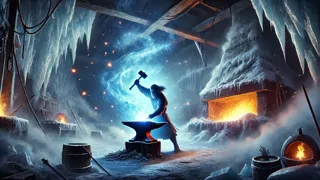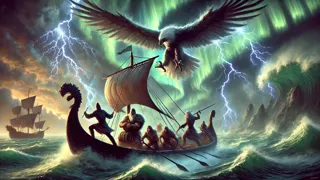Introduction
Across the land where misty forests stretch unbroken, and lakes shimmer like polished obsidian, the heart of ancient Finland beat in rhythm with stories older than the wind. In these wilds, legends lived and breathed, woven into every pine needle and whispered by the ripples on blackwater ponds. It was a time when the world was young and spirits—of earth, sky, and water—walked freely among mortals. The people of Kalevala, bound by the pulse of their land and the power of song, believed in a world alive with magic and possibility. Among them strode Väinämöinen, wise and ageless, whose voice could tame the north wind or stir the deepest longing in a listener’s soul. Renowned for his mastery of runes and the kantele’s haunting notes, he was the living memory of creation and change. Yet, even Väinämöinen, revered for his wisdom, knew that true prosperity could be as fleeting as morning frost. This is the story of his quest for the Sampo, the miraculous mill forged by magic and desire—a device that could grind out flour, salt, and gold, promising abundance to any who possessed it. But the Sampo’s promise was not so easily won. Forged by the legendary smith Ilmarinen at the urging of Louhi, the witch-queen of the cold northern land of Pohjola, the Sampo became the heart of a struggle between wisdom, cunning, and raw ambition. From the shadowed halls of Pohjola to the storm-lashed shores of the north, Väinämöinen’s journey would test the limits of his resolve, the strength of friendship, and the endurance of hope. The epic unfolds not merely as a tale of magic and theft but as a mirror reflecting humanity’s longing for security, the temptation of power, and the bittersweet lessons learned when dreams are chased across the wilds of the world.
The Birth of a Quest: Väinämöinen’s Longing and Ilmarinen’s Skill
Long before the quest for the Sampo began, Väinämöinen walked the wilds of Kalevala with a longing deeper than the endless forests. Though he was ancient as the first spring thaw, his wisdom ever thirsted for ways to secure his people’s future. Each season brought new trials: lean winters, famines that swept through villages like shadow, and the gnawing anxiety that fortune was as fickle as the wind on the lake. Yet tales spoke of a marvel in the distant north—a device of limitless bounty, waiting to be made. Väinämöinen’s vision grew restless. One night, beneath a sky throbbing with aurora, he heard an old woman’s voice drifting on the wind from the land of Pohjola. Louhi, mistress of frost and enchantment, beckoned with a riddle: only the greatest smith could forge what all hearts desired. The Sampo, she promised, would bestow endless grain, salt, and gold, yet it must be made by mortal hands.

Summoning Ilmarinen, the celestial blacksmith and master of all crafts, Väinämöinen recounted Louhi’s challenge. The promise of abundance for Kalevala was irresistible. But to gain Louhi’s favor—and her daughter’s hand for Ilmarinen—they would need to travel north, where sun rarely climbed above the trees and magic thickened the air. Thus began a journey fraught with cold winds and riddles. Väinämöinen, wise and poetic, and Ilmarinen, hands calloused by starlight and flame, journeyed together, their bond forged by shared hope and the burdens of their people.
As they neared Pohjola, the land itself seemed to bristle with warning. Wolves howled from the black forests; frost crept along their path; rivers froze solid beneath unnatural stars. Yet nothing could quell their resolve. Louhi, sharp-eyed and clever, welcomed them into her fortress of ice and smoke. She set her impossible task: forge a mill that could make anything from nothing, a Sampo that would turn want to plenty.
Ilmarinen toiled in Louhi’s smithy, where flames danced blue and white and iron sang beneath his hammer. He crafted wondrous things: a golden eagle whose wings could stir storms, a plough that cut its own furrows, but each was not enough. For seven days and nights, Ilmarinen worked without rest, drawing on all his cunning. At last, with a shudder and a rush of magic, the Sampo was born: a mill with a lid of many colors, roots sunk deep into the earth, grinding out treasure with every turn.
Louhi snatched the Sampo for herself, sealing it behind seven locks in the vaults of Pohjola. Ilmarinen was given only her grudging thanks—and a feast to send him on his way. Väinämöinen saw the joy in Louhi’s eyes and knew that as long as the Sampo stayed in Pohjola, Kalevala would never be safe from want. The seeds of longing became resolve. The time would come, Väinämöinen vowed, when the Sampo would belong to those who needed it most.
Theft and Pursuit: Väinämöinen’s Cunning and the Flight from Pohjola
The promise of the Sampo’s abundance did not linger long in Ilmarinen’s hands, nor did Louhi’s favor soften with time. Word spread among the people of Kalevala that their greatest hope remained captive in the frosted halls of Pohjola. Seasons passed; hunger returned. The rivers ran thin with fish, and the fields yielded less each year. Väinämöinen’s songs—usually rich with comfort—grew tinged with yearning. He watched the northern horizon, imagining the Sampo grinding in the depths of Louhi’s fortress, turning out wealth that never reached Kalevala.

Determined to reclaim what he saw as rightfully theirs, Väinämöinen gathered his bravest companions: Ilmarinen, strong and stoic; Lemminkäinen, fiery and impetuous; and a host of trusted allies. They crafted a mighty boat, stitched together from the heartwood of ancient birch and powered by spells woven into its planks. On a night when the aurora danced across the sky like spirits in flight, they set sail toward Pohjola.
The journey north was fraught with danger. Storms, summoned by Louhi’s magic, battered their vessel; icy winds sought to drive them from their path. Yet Väinämöinen’s voice—singing runes of protection—kept them true. They passed islands shrouded in mist, where spirits whispered and waves sparkled with ghostly fire. At last, they reached the shadowed coastline of Pohjola. Under cover of night, they crept into Louhi’s fortress, where the Sampo was guarded by spells, locks, and watchful eyes.
Ilmarinen’s skill and Väinämöinen’s cunning proved equal to the task. They tricked the sentries with illusions of false dawn and enchanted sleep. Down winding stone corridors they stole, past vaults filled with ice and forgotten dreams, until they found the Sampo—its lid glowing with shifting colors, the air thick with its magic. Working in silence, they lifted it from its roots and carried it to the waiting boat. But as they slipped into the fog-laced waters, Louhi awoke. With a scream that split the sky, she summoned winds and storms to chase them.
The chase that followed was a tempest of fury and desperation. Louhi transformed herself into a monstrous eagle, wings blotting out the moon. She clawed at the boat, trying to snatch the Sampo from their grasp. Väinämöinen and his companions fought her off with spells and song; Ilmarinen defended the Sampo with hammer and iron. The boat pitched and rolled as waves rose like mountains around them. At the heart of the storm, Louhi seized the Sampo in her talons. In the struggle, its lid shattered; treasures spilled into the sea, coloring the water gold and silver. The Sampo itself vanished beneath the churning waves, lost but not destroyed. As dawn broke, Väinämöinen looked upon the scattered remnants and knew that though they had lost the Sampo, its bounty would now be shared by all—scattered through land and sea, blessing every shore.
Wisdom from Loss: The Sampo’s Legacy in Kalevala
When the storm’s fury faded and Louhi’s wings vanished into the clouds, Väinämöinen and his companions drifted upon quiet water, hearts heavy yet strangely uplifted. The Sampo was lost to the deep, but its essence—grain, salt, gold—had mingled with the sea and soil. As they returned to Kalevala, they carried not only memories of danger and wonder but also a dawning realization: true abundance comes not from hoarding treasure but from sharing fortune with the world.

In the months and years that followed, the land itself seemed to change. Shores where the Sampo’s bounty had sunk teemed with new life: fish glimmered in the rivers; wildflowers burst in riotous color across the meadows; even the coldest fields yielded richer harvests. The people of Kalevala marveled at their sudden fortune. Stories spread like fire on a winter night—of how Väinämöinen’s wisdom and Ilmarinen’s skill had rescued hope from the clutches of darkness. Children listened wide-eyed as elders recited the tale, their voices echoing through smoky cottages and under midnight skies alive with the northern lights.
Väinämöinen himself grew quieter, his songs deeper and more thoughtful. He understood now that even loss could be a kind of gift. The Sampo, for all its promise of plenty, had sown envy and conflict between peoples. Its scattering had forced Kalevala and Pohjola alike to rely on their own labor, ingenuity, and community. The mill’s magic became a memory—one that reminded each generation to find abundance in cooperation and wisdom, rather than in possession alone.
Louhi, too, was changed by the events. Though she mourned her lost treasure, she could not help but notice that her land blossomed in ways she had never imagined. The Sampo’s loss humbled her power, tempering her ambition with respect for the balance between taking and giving. From time to time, travelers told of seeing her wandering the forests, speaking softly to ancient trees and seeking new ways to work with, rather than against, the forces of the world.
So the tale of Väinämöinen and the Sampo echoed down through centuries. The kantele’s notes drifted across silent lakes; smiths’ hammers rang in honor of Ilmarinen’s art; and people of all walks remembered that sometimes, what seems like an ending is just another beginning. In every grain of salt, every golden field, and every tale told beside a fire, the Sampo’s magic endures—reminding all who listen that true prosperity lives where wisdom, courage, and sharing meet.
Conclusion
The epic of Väinämöinen and the Sampo remains one of Finland’s greatest treasures—not simply for its magic or adventure but for the truths it carries beneath its mythical veneer. In a world forever seeking easy prosperity and fearing loss, this story offers a gentler wisdom: that abundance, once hoarded, breeds strife, but when shared freely—by choice or by fate—it multiplies in every heart and field. Väinämöinen’s journey to reclaim the Sampo is not just a tale of daring and loss but a lesson in resilience, humility, and the enduring power of hope. Even when the object of our longing slips from our grasp, what remains can nourish generations if met with gratitude and ingenuity. The forests and lakes of Kalevala are richer for the Sampo’s scattering, just as each listener is richer for hearing its story. In every telling, we remember that magic lies not only in ancient mills or lost treasures but in our willingness to share what we have, trust in each other, and face adversity with open hearts.


















